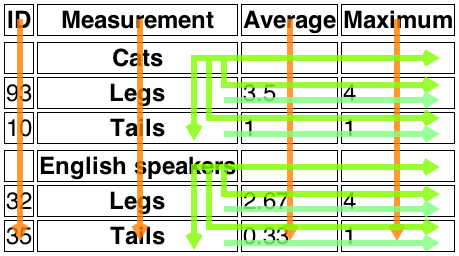jump
th elementtr element.header, footer, sectioning content, or heading content descendants.colspanrowspanheadersscopeinterface HTMLTableHeaderCellElement : HTMLTableCellElement {
attribute DOMString scope;
};
The th element represents a header cell in a table.
The th element may have a scope content attribute
specified. The scope attribute is
an enumerated attribute with five states, four of which
have explicit keywords:
row
keyword, which maps to the row statecol
keyword, which maps to the column staterowgroup keyword,
which maps to the row group stateth element's
scope attribute must not be in
the row group state if
the element is not anchored in a row group.colgroup keyword,
which maps to the column group stateth
element's scope attribute must
not be in the column
group state if the element is not anchored in a column group.The scope attribute's
missing value default is the auto state.
The scope IDL
attribute must reflect the content attribute of the
same name, limited to only known values.
The following example shows how the scope attribute's rowgroup value affects which
data cells a header cell applies to.
Here is a markup fragment showing a table:
<table> <thead> <tr> <th> ID <th> Measurement <th> Average <th> Maximum <tbody> <tr> <td> <th scope=rowgroup> Cats <td> <td> <tr> <td> 93 <th scope=row> Legs <td> 3.5 <td> 4 <tr> <td> 10 <th scope=row> Tails <td> 1 <td> 1 <tbody> <tr> <td> <th scope=rowgroup> English speakers <td> <td> <tr> <td> 32 <th scope=row> Legs <td> 2.67 <td> 4 <tr> <td> 35 <th scope=row> Tails <td> 0.33 <td> 1 </table>
This would result in the following table:
| ID | Measurement | Average | Maximum |
|---|---|---|---|
| Cats | |||
| 93 | Legs | 3.5 | 4 |
| 10 | Tails | 1 | 1 |
| English speakers | |||
| 32 | Legs | 2.67 | 4 |
| 35 | Tails | 0.33 | 1 |
The headers in the first row all apply directly down to the rows in their column.
The headers with the explicit scope attributes apply to all the
cells in their row group other than the cells in the first column.
The remaining headers apply just to the cells to the right of them.
